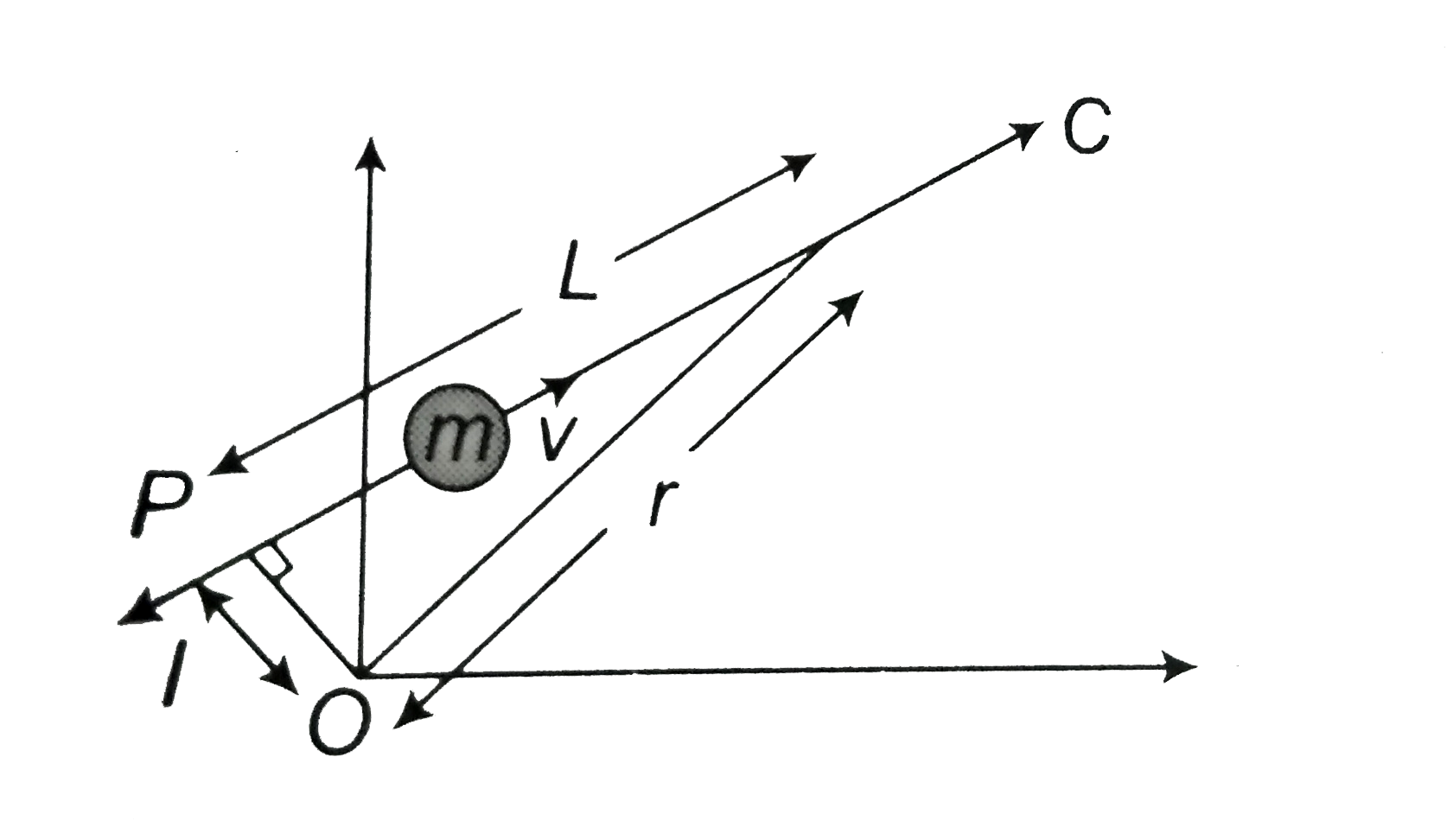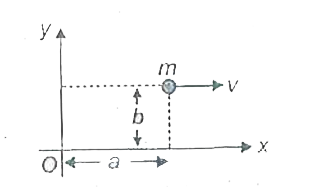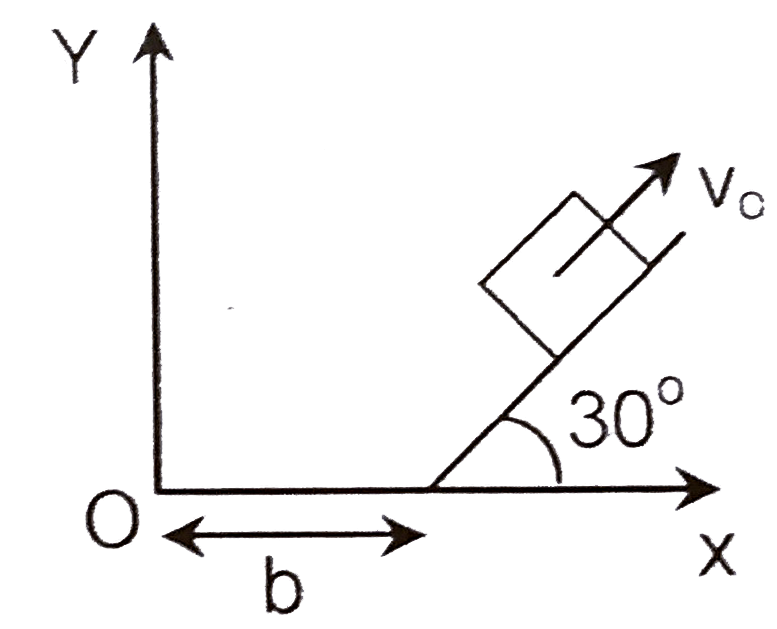A particle of mass m is moving along the line y=b,z=0 with constant speed v. State whether the angular momentum of particle about origin is increasing, decreasing or constant.
To determine whether the angular momentum of a particle moving along the line y=b,z=0 with constant speed v about the origin is increasing, decreasing, or constant, we can follow these steps:
1. Understanding the Motion:
- The particle is moving along the line y=b in the xy-plane, which means its z-coordinate is always 0. The position of the particle can be represented as (x,b,0).
2. Defining Angular Momentum:
- The angular momentum L of a particle about a point (in this case, the origin) is given by the formula:
L=r×p
where r is the position vector from the origin to the particle, and p is the linear momentum of the particle.
3. Calculating Position and Momentum:
- The position vector r of the particle is:
r=(x,b,0)
- The linear momentum p of the particle is:
p=mv=m(vx,vy,0)
where vx and vy are the components of the velocity vector.
4. Finding the Perpendicular Distance:
- The particle is moving with a constant speed v, which implies that its velocity components are constant. Since the particle is constrained to move along the line y=b, the perpendicular distance from the origin to the line of motion is simply the constant value b.
5. Calculating Angular Momentum:
- The magnitude of the angular momentum L about the origin can be expressed as:
L=r⋅p⊥
where p⊥ is the component of momentum perpendicular to the radius vector r. Since p=mv and the perpendicular distance is b, we have:
L=mvb
Here, m, v, and b are all constants.
6. Conclusion:
- Since L=mvb is a product of constants, the angular momentum L about the origin is constant.
Final Answer:
The angular momentum of the particle about the origin is constant.
- The particle is moving along the line y=b in the xy-plane, which means its z-coordinate is always 0. The position of the particle can be represented as (x,b,0).
- The angular momentum L of a particle about a point (in this case, the origin) is given by the formula:
L=r×p
where r is the position vector from the origin to the particle, and p is the linear momentum of the particle.
- The position vector r of the particle is:
r=(x,b,0)
- The linear momentum p of the particle is:
p=mv=m(vx,vy,0)
where vx and vy are the components of the velocity vector.
- The particle is moving with a constant speed v, which implies that its velocity components are constant. Since the particle is constrained to move along the line y=b, the perpendicular distance from the origin to the line of motion is simply the constant value b.
- The magnitude of the angular momentum L about the origin can be expressed as:
L=r⋅p⊥
where p⊥ is the component of momentum perpendicular to the radius vector r. Since p=mv and the perpendicular distance is b, we have:
L=mvb
Here, m, v, and b are all constants.
- Since L=mvb is a product of constants, the angular momentum L about the origin is constant.
The angular momentum of the particle about the origin is constant.
Topper's Solved these Questions
- ROTATIONBOOK - DC PANDEY ENGLISHCHAPTER - ROTATIONEXERCISE - Check point 9.1
20 Videos
- ROTATIONBOOK - DC PANDEY ENGLISHCHAPTER - ROTATIONEXERCISE - Check point 9.2
20 Videos
- RAY OPTICSBOOK - DC PANDEY ENGLISHCHAPTER - RAY OPTICSEXERCISE - Integer type q.
14 Videos
- ROTATIONAL MECHANICSBOOK - DC PANDEY ENGLISHCHAPTER - ROTATIONAL MECHANICSEXERCISE - Subjective Questions
2 Videos
Similar Questions
A particle of mass 1kg is moving about a circle of radius 1m with a speed of 1m/s. Calculate the angular momentum of the particle.
View SolutionA particle of mass 1kg is moving about a circle of radius 1m with a speed of 1m/s. Calculate the angular momentum of the particle.
View SolutionA particle of mass 1 kg is moving along the line y=x+2 (here x and y are in metres) with speed 2m/s. The magnitude of angular momentum of paticle about origin is -
View SolutionA particle of mass m is moving along the line y-b with constant acceleration a. The areal velocity of the position vector of the particle at time t is (u=0)
View SolutionA particle of mass m moves along line PC with velocity v as shown. What is the angular momentum of the particle about O?

View SolutionA particle of mass m is projected with a speed v at an angle θ with the horizontal. Find the angular momentum of the particle about an axis passing through point of projection and perpendicular to the plane of motion of the particle.
(a) When the particle is at maximum height and
(b) When the particle is just about to collide with the horizontal surface
View SolutionA particle of mass m is moving on a circular path of radius r with uniform speed v , rate of change of linear momentum is
View SolutionA particle of mass m is moving with constant velocity v parallel to the x-axis as shown in the figure. Its angular momentum about origin O is

View SolutionA particle of mass 'm' is moving on a circular path of radius 'r' with uniform speed 'v'. Rate of change of linear momentum is
View SolutionA cube of mass m and side a is moving along a plane with constant speed vo as shown in figure. The magnitude of angular momentum of the cube about z -axis would be.

View Solution
